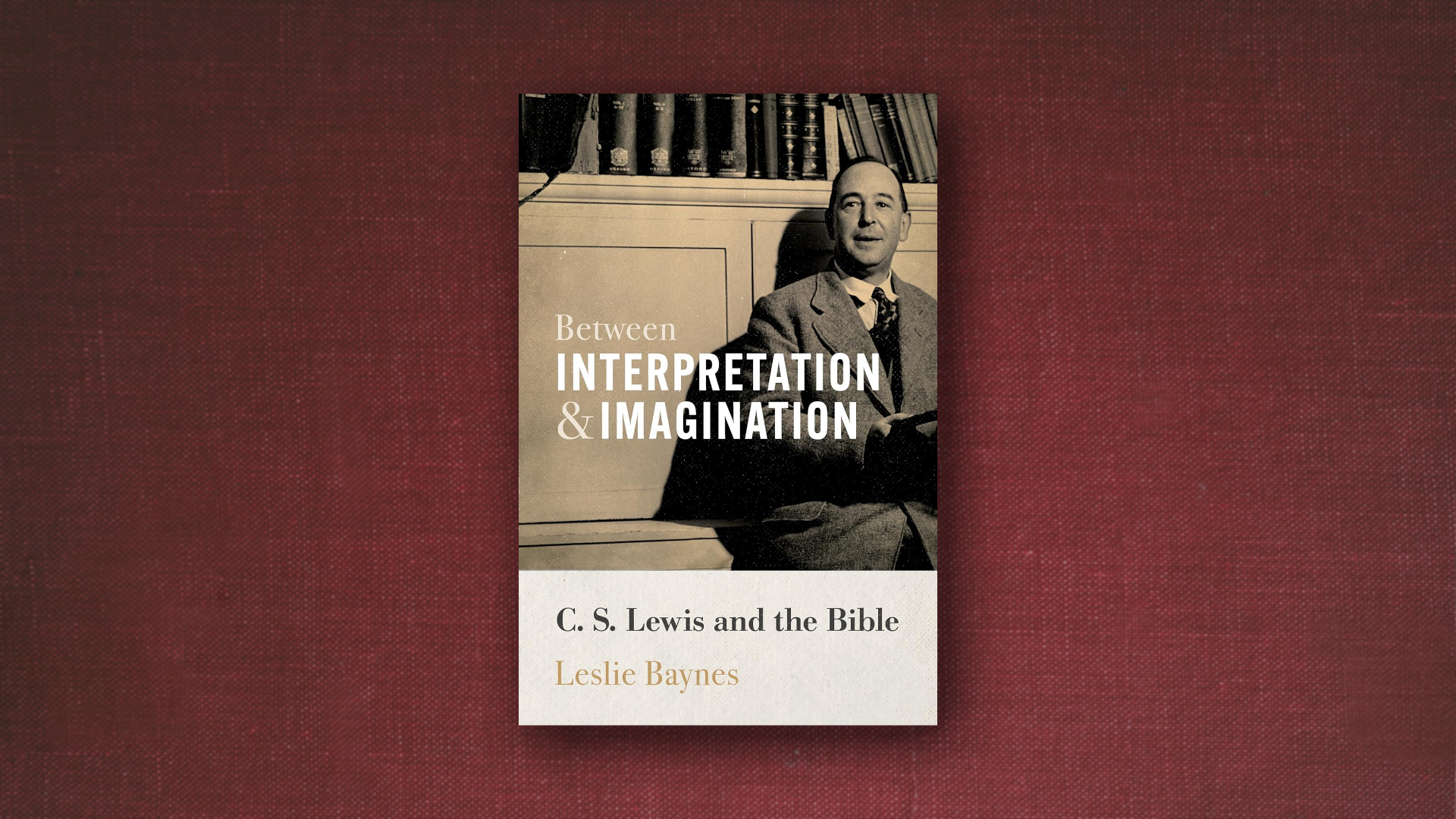In his 1945 essay “Meditation in a Toolshed,” C. S. Lewis described standing in a dark toolshed and looking at a sunbeam piercing through a crack in the shed door. He then changed locations so the sunbeam “fell on [his] eyes.” The dust and the toolshed disappeared, and he saw the trees outside and, of course, the sun, “90 odd million miles away.”
Lewis was making an important distinction between two ways of seeing: looking at something and looking along something. It’s the distinction between examining something and experiencing it.
Both ways of seeing are demonstrated in Leslie Baynes’s book Between Interpretation and Imagination: C. S. Lewis and the Bible. For the first 200 pages, Baynes, associate professor of New Testament and Second Temple Judaism at Missouri State University, uses her skill as a biblical scholar to look at Lewis’s approach to Scripture in his nonfiction work, which she criticizes for being misdirected. She then shifts to a more sympathetic approach to Lewis as she considers his allusions to Scripture in The Chronicles of Narnia.
For much of this book, Baynes expends too much effort using Lewis’s first way of seeing, looking at him with a critical eye. By ignoring his second way of seeing, she misses much of what Lewis, the 20th century’s most popular apologist, was trying to communicate.
Lewis and Higher Criticism
To fans of Lewis, Baynes comes off as surprisingly hostile toward his intellectual capacity and his handling of Scripture. For example, she argues that Lewis’s essay “Modern Theology and Biblical Criticism” was “the worst thing he ever wrote on Scripture” (111). In composing it, she argues, “he wasn’t a good reader” as “he misread almost every text he touched” (162).
She objects that Lewis was insufficiently enamored of modern skepticism toward the Bible. She complains, “Throughout his life . . . Lewis ignores, rejects, mischaracterizes, or as we shall see, even sneers at scholarship on John that differs from his own views” (120).
Baynes’s hostility evinces a prosecutorial tone. At times it’s distracting. In making her case that Lewis often misrepresented his sources, Baynes engages in her own subtle misrepresentation. For example, she uses a statement by Walter Hooper in the preface of Lewis’s Selected Literary Essays to assert that when Hooper checked the included texts, “he discover[ed] that Lewis misquoted his sources nearly five hundred times” (42).
Yet that’s not exactly what Hooper, Lewis’s secretary and posthumous editor, writes. The preface instead says, “I have made 500 corrections.” These may have been “the fault of the author or the publisher or both.” There was likely some overconfidence involved, as Hooper notes, “Because [Lewis] remembered almost everything he read, he usually quoted straight from memory without bothering to check the texts themselves.”
There’s no doubt that minor errors crept into Lewis’s academic work. But Hooper argues that these rarely changed the text’s meaning. Nevertheless, Baynes infers that Lewis intended to misrepresent those he interacted with. That conclusion can’t be drawn from Hooper’s words.
There’s no doubt that minor errors crept into Lewis’s academic work. But Hooper argues that these rarely changed text’s meaning.
This line of criticism is like that first way of seeing inside Lewis’s toolshed; she’s looking hard at Lewis. Her angst toward his handling of biblical higher criticism may be understandable, considering she’s an academic specializing in biblical studies. However, her charge that Lewis “wasn’t a good reader” or that he was guilty of ignoring or rejecting sources is exaggerated.
I’m reminded of Lewis’s Oxford colleague Helen Gardner, who described Lewis’s intense focus while reading in the Bodleian Library: “One sometimes feels that the word ‘unreadable’ had no meaning for him. To sit opposite him . . . was to have an object lesson in what concentration meant.” This is hardly the description of a careless or flippant reader.
Lewis’s Biblical Imagination
A second line of Baynes’s criticism may seem more concerning to many evangelical fans of Lewis. She accuses Lewis of “inventing Scripture” in the essay “What Are We to Make of Jesus Christ?” (191)
In the passage Baynes finds offensive, Lewis has Christ speaking words that aren’t in the Gospels. Lewis writes, “The moment at which the High Priest said to Him, ‘Who are you?’ ‘I am the Anointed, the Son of the uncreated God, and you shall see Me at the end of all history as the judge of the universe’” (191). Baynes correctly notes that these aren’t Christ’s words. It would seem the case is closed.
However, this is an example of Lewis using the literary device of a composite. He’s condensing several ideas (or characters) into one brief narrative. This is a device Lewis uses frequently in Mere Christianity, for example, when he writes, “Christ says, ‘Give me All. I don’t want so much of your time and so much of your money and so much of your work: I want You.’” Those words aren’t found in the Gospels either.
Had Baynes used Lewis’s second way of seeing from the toolshed, of experiencing the object under observation, she would have found a better way of reading writing like this from Lewis. In such instances, Lewis’s writing is like the sunbeam in the toolshed illuminating the larger ideas he’s trying to convey.
Narnia to the Rescue
Yet despite Baynes’s strong critique of Lewis’s handling of Scripture in his nonfiction works, the mood brightens when she switches focus to Lewis’s use of Scripture in The Chronicles of Narnia. In the latter portion of the book, she employs Lewis’s second way of seeing, in that she helps us experience Narnia more intensely by highlighting Lewis’s use of biblical allusions.
This portion of Baynes’s book would have been particularly helpful for me as an adult. I came to know Lewis through Narnia 30 years ago on a family vacation. This was before cell phones, iPads, and screens, and I asked my wife how we were going to entertain the children for 14 hours. She said, “We’re going to read The Chronicles of Narnia.” I was a Christian, yet I’d never heard of them. Two hours into The Magician’s Nephew, I was hooked.
Lewis’s writing is like the sunbeam in the toolshed illuminating the larger ideas he’s trying to convey.
Of all the books and resources aimed at those seeking to grow in their faith using the Chronicles, this section of Baynes’s book is one of the best I’ve read. The prosecutorial tone disappears, and we find both a quantitative and qualitative depth of examples that others lack.
For example, while examining The Voyage of the Dawn Treader, Baynes connects Reepicheep, who rode his coracle over a wave to disappear into Aslan’s country, with Enoch, who walked with God and was no more. That’s a parallel I’d never considered. This second section would have made a wonderful publication on its own.
The standard for new books about Lewis is to uncover new material that hasn’t been trod before. It takes a thorough knowledge of all things Lewis to do so, combined with a historian’s determination to dig. Despite her dislike for Lewis’s approach to higher criticism, Baynes has demonstrated both. Between Interpretation and Imagination will challenge many Lewis fans, but it’ll also call them to read him more appreciatively as they look along the sunbeam of his writing.
News Source : https://www.thegospelcoalition.org/reviews/between-interpretation-imagination/
 Your post is being uploaded. Please don't close or refresh the page.
Your post is being uploaded. Please don't close or refresh the page.





